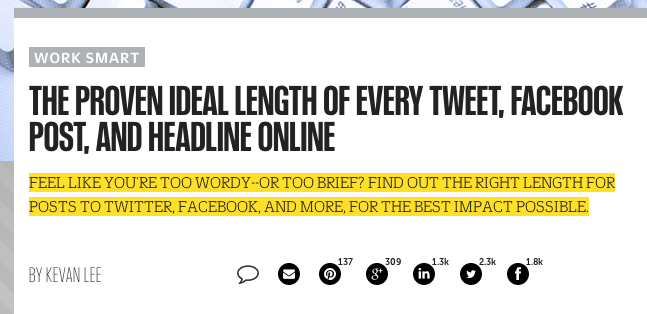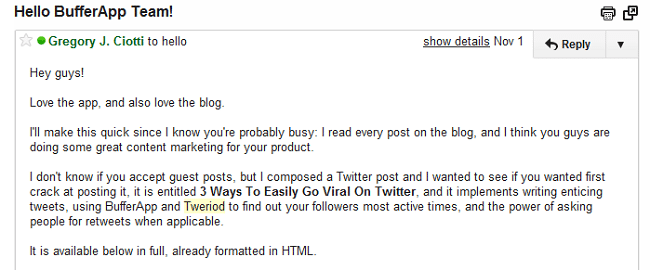How to Become a Columnist: The Ultimate Blueprint for Guest Blogging and Syndication
Former VP of Marketing @ Buffer

Being a columnist means something a bit different to me than it did growing up. When I started down my writing path, I adored magazines and newspapers and the superheroes who wrote weekly or monthly columns in the op-eds or the back pages.
Now, I adore those who write at my favorite blogs and websites. The back page of Sports Illustrated has become, for me, the featured spot on Huffington Post.
And the most amazing news of all is that being a columnist online is a dream that anyone—you, me, your team—can have come true. It just takes a little hard work and a helpful blueprint.
Buffer’s path to syndication on Huffington Post, Fast Company, Inc, and more
We are so very fortunate at Buffer to have republishing connections with some truly amazing sites: Huffington Post, Fast Company, Inc, Lifehacker, The Next Web, and more. How did these relationships come about? There was a lot of hard work and simply stellar writing by our co-founder Leo and our first content crafter Belle.
The first step toward our syndication was guest blogging. And lots of it! Leo wrote around 150 guest posts in a nine-month period. The process was huge for spreading awareness about Buffer, building a relationship with influencers and a portfolio of quality writing, and establishing the Buffer blog as an authority on lifehacking and social media.
Writing such a high volume of content helped us refine and improve the content that appeared on our own site, too. We ended up having a couple of huge hits:
10 Simple Things You Can Do Today That Will Make You Happier, Backed By Science – This post has received nearly 125,000 likes on Facebook.
Why Facebook Is Blue: The Science of Colors in Marketing – This post has received over 14,000 shares on Twitter.
When we chose to pitch a few sites on republishing our content, having huge hits like these gave us instant credibility. We shared our best stuff. In turn, the sites we pitched to received built-in validation that our posts would resonate with readers.
Awesomely, a number of sites found our content worth sharing with their audience. We built relationships with Huffington Post, Fast Company, and others, and we’ve now shifted focus completely from guest blogging to syndication. Our republishing efforts nowadays include Courtney emailing our top stories of the week to our contacts at these sites or the sites themselves coming straight to us with posts they want to grab.
It’s an incredible advantage to have content that drives traffic from multiple places—especially when you only have to write it once.

Hard work, top-notch writing, plus a touch of bravery to put yourself out there—these are qualities that are by no means unique to us. You have them, too. Here’s a bit more on how to combine them all into a columnist opportunity.
3 huge advantages to being a columnist
1. Greater awareness for your brand and content
The more places you can spread your name and your brand, the more likely you are to reach a new audience. If we were to post only to the Buffer blog, it’s possible we’d miss out on visitors from HuffPo or Fast Company who read stories in one place but not the other. In fact, when I was first learning about Buffer, I tracked back to the Buffer blog from a syndicated post.
For proof of this boost in awareness, you can track a couple different metrics. You can check your referral traffic and make note of the incoming links from the sites where you’re published. In Google Analytics, this report is found under Acquisition > All Referrals.

Additionally, you can look at the share counts of posts to gauge how much more awareness you’ve earned with your column. Fast Company republished our story on the ideal length of all online content, and it resulted in 6,000 additional shares on social media.

The second benefit of being a columnist is that it helps you establish yourself as an authority on a subject. The more places you write quality content, the more readers who will see you, and the more likely you are to be considered an expert in your field.
We’ve talked a lot about persuasion before, so you might be familiar with some of the psychological theories at play here. One of them is the Yale Attitude Change Approach, which suggests that credibility is an important element of persuasive speech. If people believe you’re credible, they’re more likely to believe your message. One way to gain credibility is to have a bio with links to all the places you’ve been published.
3. An opportunity to share your best resources
Put another way: You get to include links to your best stuff.
At Buffer, we choose to look at these inbound links in terms of happiness. We republish and syndicate because we feel it is the right thing to do to share our content with as many people as possible who might find it useful. Rebecca Churt of Hubspot has a lovely term to describe the way we all should write: content altruism. Essentially, this means adding value to the web without worrying about what you might gain.
It’s also worth noting that guest posting as a means of link building has become a favorite practice of spammers, which is why Google’s Matt Cutts publicly denounced the practice. The takeaway from Cutts’ post is that guest blogging done well is still viable and that linking to helpful resources is absolutely encouraged. Cutts even went so far as to elaborate on his post with this disclaimer:
There are still many good reasons to do some guest blogging (exposure, branding, increased reach, community, etc.). Those reasons existed way before Google and they’ll continue into the future. And there are absolutely some fantastic, high-quality guest bloggers out there.
The great debate: Guest posts vs. syndication
Before we get too deep, it’s probably going to be helpful to discuss the differences, benefits, and drawbacks to two main kinds of columnist content. Generally speaking, columnists fall into two categories: writing guest posts for a different blog or reposting your content somewhere else.
Guest posting is submitting original content to publish one time on someone else’s site.
Syndication is the republishing of an original piece of content at another site.
Each method has its pros and cons. In general, here is the good and bad about each:
Guest posts:
- Good: Unique, high value content that isn’t seen anywhere else
- Bad: Takes a lot of time to create
- Good: Strong relationship-building with other sites, good links back
- Bad: If the post and approach aren’t top notch, Google might penalize you
Syndication:
- Good: Huge time-saver and efficiency hack; press publish once and reap the rewards from many different sites
- Bad: Possible SEO drawbacks (see below)
- Good: Proven, validated content to pitch to big sites
- Bad: Potential loss of authority—Folks might not see your site as the go-to spot on a topic if your expertise is everywhere
I mentioned above that our focus is now on syndication. Every month on our open marketing reports, we list the sites we are privileged to republish at, and those sites bring us a fair amount of conversions. In republishing efforts from our top four sites last month, we had 949 new conversions to Buffer.
In our case, we feel that the benefits of syndication outweigh the downsides. Your situation may be quite different than ours, so it’s important to take a close look at your numbers and your goals and then decide from there. It should also be mentioned that part of our joy with syndication is in getting to share our content with anyone who might find value in it. In some ways, we feel that keeping content only at Buffer is a rather selfish act. If others can use it, then we don’t want to stand in the way.
A compromise: Guest posting, THEN syndication
Another option is to combine the two types of columnists. Begin with guest posts and transition to syndication later.
That’s the route we went with our content strategy at Buffer. Once we became established with guest posting, we moved to syndication. It’s interesting to note, too, how certain blogs may include both guest posting and syndication. We have been fortunate to have some really incredible writers guest post for us here at the Buffer blog. James Clear and Gregory Ciotti each come at it from a different perspective. James has been syndication from Day One. He approached us with a pitch to republish a well-performing article from his site. Gregory always writes original content. He puts great thought and effort into coming up with something new every time.It’s also fun to look back at how we first connected with Gregory. Here’s his initial pitch:

5 techniques from the experts on how to spread your content far and wide
Write a lot, and do so in your niche
Neil Patel’s advice on guest blogging starts with a call to write, on your own site, before even entertaining the idea of guest blogging. His advice comes in four parts:
- Write content in your niche
- Write content under your own name
- Write content that is publicly accessible
- Link to influential writers and sites
Put another way, you are approaching guest blogging from the perspective of the site that is hearing your pitch. Can they find your work online? Will what they find be relevant to the topic you’re pitching?
Many people write on hobby topics that interest them. This is perfectly fine (and a lot of fun!), but it may not be helpful in landing a guest blog spot. Find your niche, write for your niche, then begin your outreach.
Remix “de-risked” contentWalter Chen of iDoneThis uses de-risked content to map out his successful guest blog posts. What is de-risked content? It’s basically finding content that has worked before (and hence has less risk in terms of whether or not it will resonate) and borrowing elements to make a new post.
Walter uses an example of a post he hacked together with de-risked content from a pair of popular Hacker News pieces. The results: tens of thousands of reads and shares and some huge exposure for his app.
A great way to get started with de-risked content is to find some leading blogs in your niche and take note of what they do well—headlines, topics, formatting, style.
Pitch only your best work
This strategy from Larry Kim at Wordstream resonates a lot with us here at Buffer. We took a similar route with our guest posting and syndication. Kim counts Hubspot, Moz, Inc, and Marketing Profs among his many columnist spots, and he maintains that columnist spots like his really are something anyone can achieve.
This can happen for anyone. I started out a nobody, pitching writers at industry publications in hopes of getting picked up.
I was careful to only pitch them great stuff, so they would come to appreciate my contributions and ask me to contribute as a columnist. At that point, I’ve come full circle. I no longer have to pitch anyone since I’m a columnist there. See how that works?
The fine art of the pitch: Appreciation, brevity, and validation
Our co-founder Leo has some incredible intuition on how to best pitch a story to a potential publisher. His emails include several key ingredients: specific appreciation for the site you’re contacting, a one- or two-sentence overview of your post, and a reference to the other spots you’ve been published. Here is an actual email that he used to get a guest post spot.
Hi guys,
As a guy just starting out with a few basic web design lessons, I found onextrapixel extremely helpful, so just a quick thank you on that note.
I wanted to ask if you are interested in a guest post that I have drafted, which I titled “10 Tools To Make The Most of Twitter”. It covers a few of the latest Twitter Tools, which help me a lot to stay productive.
I hope you can let me know if you think the post could be interesting for you.
For reference of my writing style, I published recently on Six Revisions and SocialMediaExaminer.
Best,
Leo
(You might also notice that Leo references that the post is in draft. This is a neat writing hack—use validation from a positive response as motivation for completing the article. He calls this influencing your behavior, not your intentions.)
Since we don’t guest post as much anymore at Buffer, our outreach pitches look slightly different than the above example. You might notice some similarities to our guest post pitch, specifically with brevity and validation. (And notice the specific callout that we’re sharing our best content.)

Give away your content to anyone
Leo Babauta of Zen Habits openly encourages people to use his content—in part or in full with no need to ask permission.
Babauta calls this uncopyright. He explicitly states that all his content is in the public domain and that he’s released all copyright on his work. Everything he’s written at Zen Habits is freely available.
What’s the result of doing something so uncommon? As you might have guessed, taking copyright off your work removes a barrier for having your content spread to new places. So long as republished work is attributed, Babauta will receive the benefits that columnists receive: greater exposure, greater authority.
If someone feels like sharing my content on their blog, or in any other form for that matter, that’s a good thing for me. If someone wanted to share my ebook with 100 friends, I don’t see how that hurts me. My work is being spread to many more people than I could do myself. That’s something to celebrate, as I see it.
Miscellaneous considerations
What are the SEO implications of syndication and duplicate content?
When the same story appears in multiple places, search engines have to decide which one to display in results and which one deserves the link juice. The best tip here is to make sure that your syndicated content includes a link back to the original. Search engines can typically figure things out from there.
How can I find the right person to contact at a website?
Along with sending a solid pitch, you’ll also want to be pitching the right person. We’ve found success by contacting the features editor or contributions editor at large sites.
Which sites are best for outreach and media partnerships?
As you browse the web, take note of articles that include a reference along the lines of “This story originally appeared…” This is a sure sign that the site allows republished content. With guest posting, an article might explicitly state that it was written as a guest post or you may need to read the author’s bio to see whether they are employed by the website or not.
Specifically, a couple places we started out with at Buffer were Business Insider, Search Engine Journal, and Social Media Today.
What has been your experience with guest posting and syndication?
I’d love to hear what you’ve discovered along the road to becoming a columnist. Were these tips helpful? Do you have some tips to share from your own experience? I’d love to share more with you in the comments.
P.S. If you like this post, you might also like The Ultimate Guide to Repurposing Content: How to Extend the Life of Every Article You Write and 8 Important Actions for Making the Most of Your Guest Post Opportunity.
Image credit: 500CPM
Try Buffer for free
140,000+ small businesses like yours use Buffer to build their brand on social media every month
Get started nowRelated Articles

Learn how to leverage AI social media content creation tools and save valuable time in your social media marketing efforts.

With the newsletters on this list, you'll be able to stay on top of all developments in social media and learn from amazing experts

If you always feel like you’re chasing the tail-end of audio trends on the app, you’ve come to the right place. In this article, I’ll guide you through all the methods you can use to find the most popular music and sounds on Instagram before they drop off the charts.